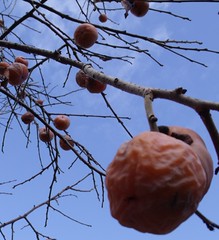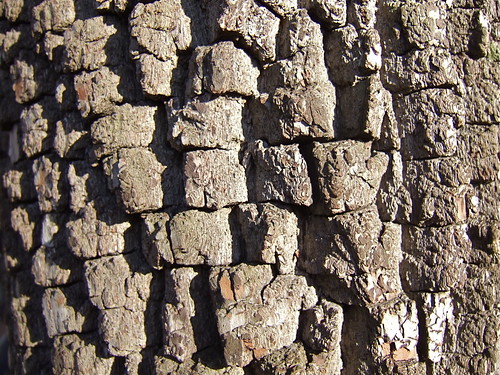 I have a very early (and not entirely pleasant) childhood memory of getting pelted with persimmons as my mother shook them out of a tree in the woods near our house. Sometime in my twenties I overcame this trauma, and now I am likely to be the one shaking them town. Their scientific name says it all -- Diospyros virginiana, the Virginian food of the gods.
I have a very early (and not entirely pleasant) childhood memory of getting pelted with persimmons as my mother shook them out of a tree in the woods near our house. Sometime in my twenties I overcame this trauma, and now I am likely to be the one shaking them town. Their scientific name says it all -- Diospyros virginiana, the Virginian food of the gods. Persimmons have come up with an ingenious method for protecting themselves until they're fully ripe: they are horribly, mouth-puckeringly astringent when immature. There is a common saying (among folks who eat persimmons, at least) that a frost makes persimmons lose this astringency. This is close, but not exactly true: persimmons ripen up around the time of our first frost, but the two events aren't related. We've found edible persimmons before a frost, and horribly astringent ones after frost.
 The real rule of thumb is that you only want to eat fruit that are gooey-soft and falling off the tree. Give the trunk a gentle shake and collect the fruits that fall. (Beware any fruit that are still attached to a twig when they fall: they weren't actually ready to come down yet.) Before you eat a whole fruit, take a small bite and wait a minute to make sure it's not going to make your mouth feel like it's been sucked dry: the puckering power of the persimmon is definitely related to how much you've eaten. You can take home close-but-not-quite-ripe fruits and let them continue ripening indoors for a week or two. But don't let all this talk of astringency scare you off: when they're good, they're really, really good.
The real rule of thumb is that you only want to eat fruit that are gooey-soft and falling off the tree. Give the trunk a gentle shake and collect the fruits that fall. (Beware any fruit that are still attached to a twig when they fall: they weren't actually ready to come down yet.) Before you eat a whole fruit, take a small bite and wait a minute to make sure it's not going to make your mouth feel like it's been sucked dry: the puckering power of the persimmon is definitely related to how much you've eaten. You can take home close-but-not-quite-ripe fruits and let them continue ripening indoors for a week or two. But don't let all this talk of astringency scare you off: when they're good, they're really, really good. At this time of year, you have two ways of identifying a persimmon tree: by bark, and by fruit. The bark is dark grey and chunky, broken up into squares. Learning to recognize it is key, because the fruits are usually well above eye level. When you see the bark, look up: the fruits are round and orange, about the size of a golf ball, hanging on the tree long after it has lost its leaves. Each fruit has a distinctive four-part sepal on top. There's nothing I can think of that you could confuse them with. So, shake away!
At this time of year, you have two ways of identifying a persimmon tree: by bark, and by fruit. The bark is dark grey and chunky, broken up into squares. Learning to recognize it is key, because the fruits are usually well above eye level. When you see the bark, look up: the fruits are round and orange, about the size of a golf ball, hanging on the tree long after it has lost its leaves. Each fruit has a distinctive four-part sepal on top. There's nothing I can think of that you could confuse them with. So, shake away!In the wild: Persimmons need sun to set a lot of fruit. You'll often see them on the edges of woods. We know of a few on the C&O Canal between Great Falls Tavern and the falls, and many along the Northwest Branch of the Anacostia north of Colesville Road. And we always keep an eye out for fruit along Eastern Avenue at Jecquie Park in Takoma, where there's a tall persimmon right next to the sidewalk.
In your yard: Persimmons can grow in a wide range of soils. You'll need sun, and room for a tree that will eventually be 20 feet or more. Edible Landscaping has a selection of saplings grafted from trees found in the wild with unusually large fruits. They appear to have also grafted them to be self-fertile, which is important, because wild persimmons have male and female trees.
Do you have a persimmon story, or a favorite spot where you find persimmons? Leave us a comment!
Like the photos in this post? Mouse over for credits; a click takes you to the photographer on Flickr.


